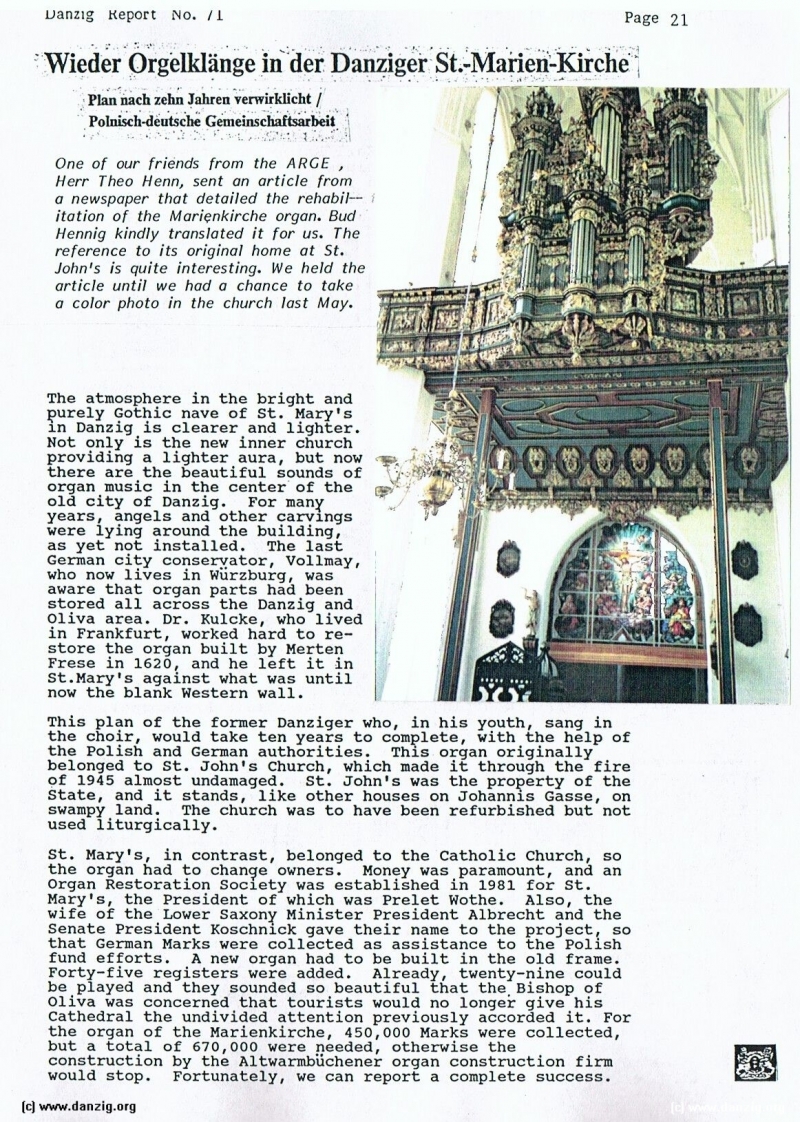
Wieder Ôrgelklange in der Danziger St.-Marien-Kirche
Plan nach zehn Jahren verwirkbcht / Polnisch-deutsche Gemeinschaftsarbett
One of our friends from the ARGE , Herr Theo Henn, sent an article from a newspaper that detailed the rehobil— itation of the Marienkirche organ. Bud Hennig kindly translated it for us. The reference to its original home at St. John’s is quite interesting. We held the article until we had a chance to take a color photo in the church last May.
The atmosphere in the bright and ure1y Gothic nave of St. Mary’s in Danzig is clearer and lighter. Not only is the new inner church providing a lighter aura, but now there are the beautiful sounds of organ music in the center of the old city of Danzig. For rnan’ years, angels and other carvings were lying around the building, as yet not installed. The last German city conservator, Volimay, who now lives in Wurzburg, was aware that organ parts had been stored all across the Danzig and Oliva area. Dr. Kuicke, who lived in Frankfurt, worked hard to restore the organ built by Merten Frese in 1620, and he left it in St.Mary’s against what was until now the blank Western wall.
This plan of the former Danziger who, in his youth, sang in the choir, would take ten years to com,lete, with the help of the Polish and German authorities. This organ originally belonged to St. John’s Church, which made it through the fire of 1945 almost undamaged. St. John’s was the property of the State, and it stands, like other houses on Johannis Gasse, on swampy land. The church was to have been refurbished but not used liturgically.
St. Mary’s, in contrast, belonged to the Catholic Church, so the organ had to change owners. Money was paramount, and an Organ Restoration Society was established in 1981 for St. Mary’s, the President of which was Prelet Wothe. Also, the wife of the Lower Saxony Minister President Albrecht and the Senate President Koschnick gave their name to the project, so that German Marks were collected as assistance to the Polish fund efforts. A new organ had to be built in the old frame. Forty—five registers were added. Already, twenty—nine could be played and they sounded so beautiful that the Bishop of Oliva was concerned that tourists would no longer give his Cathedral the undivided attention previously accorded it. For the organ of the Marienkirche, 450,000 Marks were collected, but a total of 670,000 were needed, otherwise the construction by the Altwarmbüchener organ construction firm would stop. Fortunately, we can report a complete success.
Danzig Report Vol. 1 - Nr. 71 - April - May - June - 1991, Page 21.
Hits: 3211
Added: 30/06/2015
Copyright: 2025 Danzig.org

